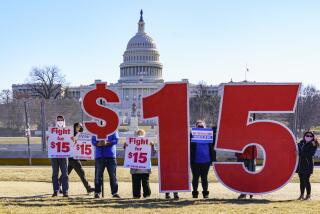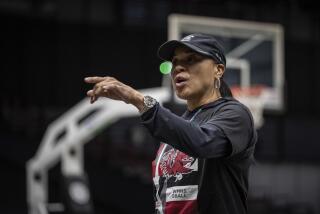Wage Equity Concept Wanes as Women Slowly Close Pay Gap
- Share via
WASHINGTON — Are “comparable worth” programs working?
The programs, established during the 1980s, were intended to overcome practices in which employers often paid women and members of minority groups less than they paid men for virtually the same sort of jobs. But progress so far has been slow.
Census Bureau figures show that in 1989 full-time female workers made 68.6 cents for every $1 that full-time male employees earned, up from about 59.7 cents a decade before but well short of achieving parity with men.
To close this gap, supporters of equity in pay want salaries for jobs in which females make up the majority of the workers--such as nursing and child-care--re-evaluated.
“(Pay equity) is an important component of any economic justice campaign,” said Claudia Wayne of the National Committee on Pay Equity.
But opponents of the concept say that trying to equalize pay will wreak havoc in the marketplace and could hurt women and minority members by discouraging employers from hiring more workers in female-dominated professions.
BACKGROUND: Pay equity was an issue on the move during the mid-1980s. About 22 states and the District of Columbia studied the issue, and six--New York, Washington, Oregon, Wisconsin, Iowa and Minnesota--altered their pay structures as a result.
The National Committee on Pay Equity’s Wayne estimates that states spent $500 million on wage adjustments during the 1980s.
A study by the Urban Institute said Minnesota’s pay equity program increased women’s relative pay by 9 percentage points in the four years preceding January, 1987. Before that, women in state government earned only 72% as much as men.
The province of Ontario, in Canada, went even further. Since 1988, both government and private-sector employers there have been required to study their work forces for gender-based wage discrimination and make appropriate adjustments.
But a study of Washington state’s comparable-worth program--conducted by June O’Neill, a Baruch College economist--found that, although pay scales increased markedly in female-dominated state jobs, the groups that received the largest pay hikes also appeared to have fewer new hires.
Also, the pay equity movement suffered several setbacks. Courts, for the most part, resisted the concept. Few private companies embraced it. And women’s rights activists often focused on other issues.
Indeed, Baruch College’s O’Neill argues that part of the reason that the issue has waned is that women are making strides toward closing the pay gap. For example, female college graduates between 25 and 34 who are working full time earn 80% of what male colleagues do.
THE OUTLOOK: A suit is pending in a U.S. court in New York in which members of the American Federation of State, County and Municipal Employees charge that Nassau County is discriminating in its pay scales.
In April, the union and New York City reached a $7.5-million agreement to raise wages of 911 dispatchers--predominantly women and minority members--who were paid less than mostly male fire department dispatchers.
But no one expects major gains for pay equity in the near future. “If women do better in the next few years, it will be because of labor market conditions and not comparable worth,” said Suzanne Donovan, who is writing a book on the pay equity debates.
The Wage Gap
The median annual earnings of year-round, full-time workers. All men: $27,430 (100%) White: $28,541 (100%) Black: $20,426 (71.5%) Latino: $18,358 (64.3%) All women: $18,778 (68.6%) White: $18,922 (66.2%) Black: $17,389 (60.9%) Latino: $15,662 (54.8%) Source: U.S. Census Bureau
More to Read
Inside the business of entertainment
The Wide Shot brings you news, analysis and insights on everything from streaming wars to production — and what it all means for the future.
You may occasionally receive promotional content from the Los Angeles Times.







